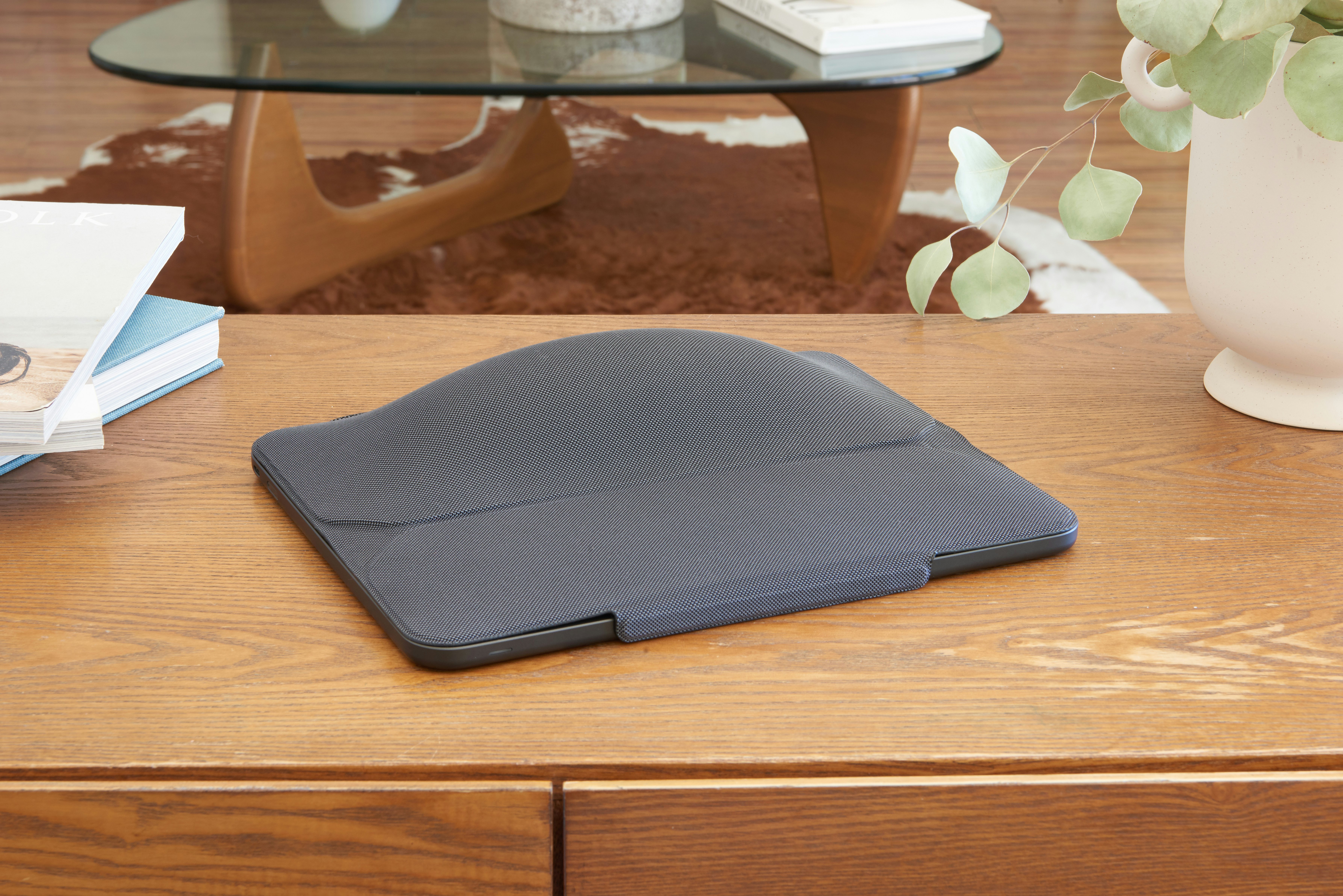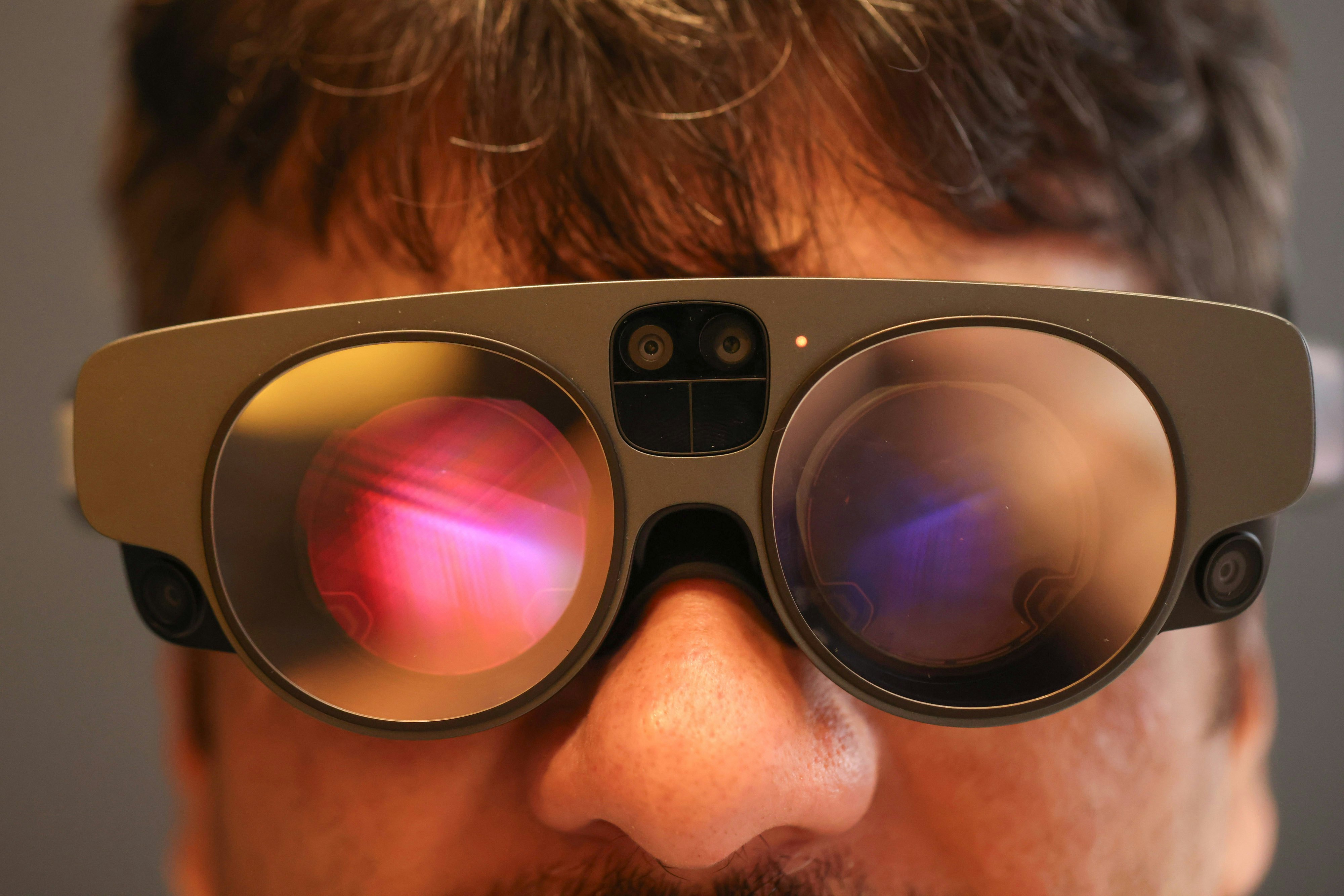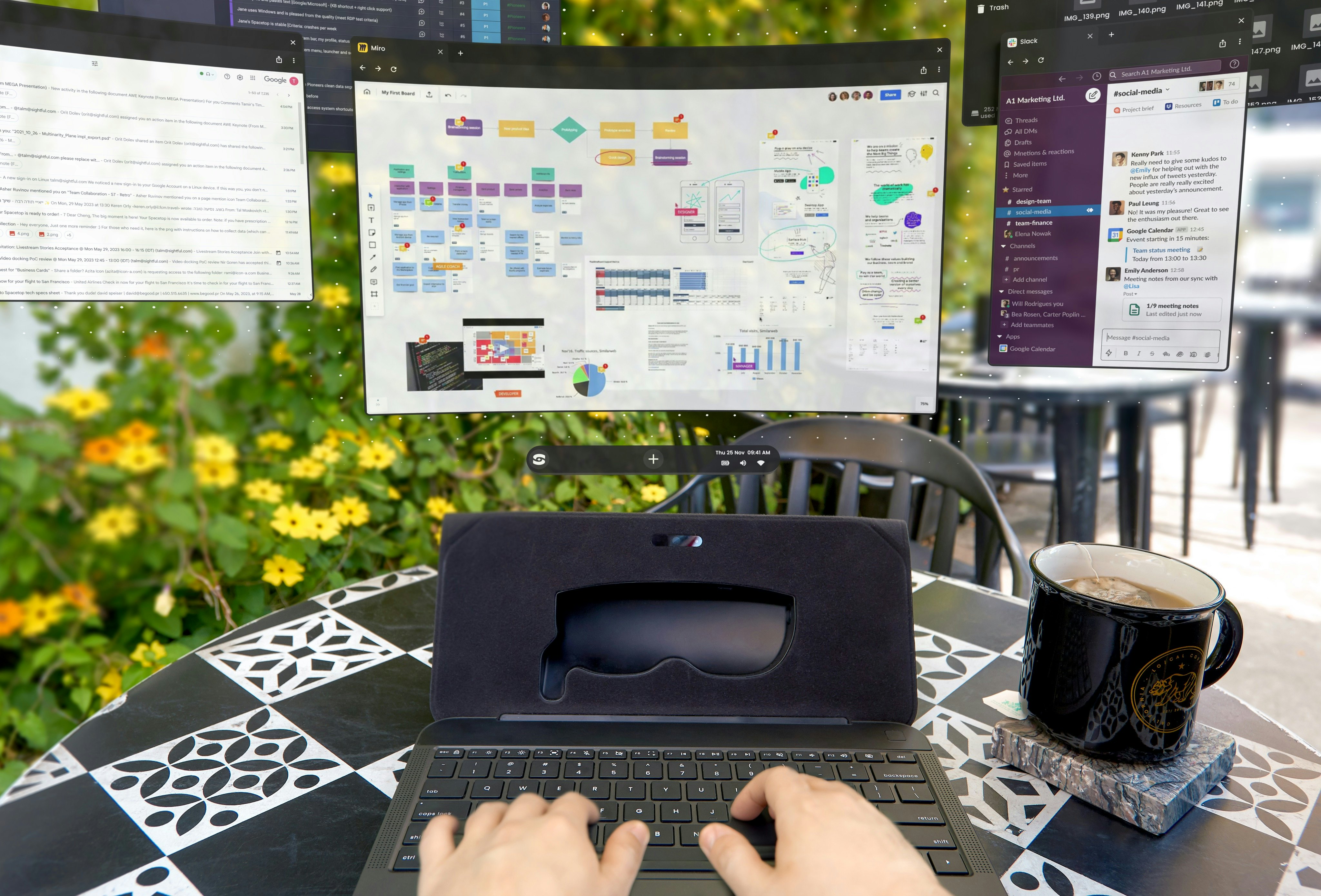
You don’t need to strap on a heavy headset or deal with hand tracking to get a taste of the potential of spatial computing. The Spacetop G1, a computer created by a startup called Sightful that combines augmented reality glasses with the bottom half of a laptop, has spent the last year in early access, but now after some refinements, it’s available to pre-order.
We’ll have to wait until WWDC 2024 to see where Apple takes the Vision Pro and visionOS next, but wherever reviewers landed on the headset, there’s a clear agreement that Apple’s vision of a future full of resizable, ever-present virtual windows is a winner. With the $1,900 Spacetop G1, Sightful has basically taken that idea and made it the de facto reason for the AR laptop’s existence, stripping away the hardware bulk and novel interactions the Vision Pro is designed around, and replacing them with the familiarity of trackpads and keyboard shortcuts.
The Spacetop G1 won’t ship until October, but after speaking to the team at Sightful, including the startup’s CEO, Tamir Berliner, there is a compelling case that however headsets develop, there’s a useful version of spatial computing that can exist right now, and it doesn’t need to alienate people who are used to using a laptop.
Spacetop G1

If you can imagine a laptop without a display, you can picture the Spacetop G1. The bottom half of the device should be familiar to anyone who’s used a MacBook Pro. All of the keys you need are present, the trackpad is smooth and spacious, and even with a pair of glasses attached, the Spacetop G1 is slim enough to fit into a backpack, and light enough at 3.3 pounds to still feel portable.
“All the design [of the G1] is based on early access, but the goal has always been to have a true laptop that can be used for all-day productivity,” Orit Dolev, Sightful’s senior director of product and design, tells me over Zoom.
“What the eye sees is just an edge. If you break that and you smooth the edge, you get rid of that sensation of, ‘I’m stuck in a square.’”
The key difference between the Spacetop G1 and its laptop cousins is that jutting out of the bottom of the device is a fabric cable that connects to a pair of augmented reality glasses. These slot into a holder built into the Spacetop G1’s cover, that’s also home to a webcam for video calls, and they’re the sole way you can see what you’re interacting with the device.
While that sounds like some kind of Frankenstein MacBook, in practice, it’s actually most similar to a Chromebook. The Spacetop G1 runs SpaceOS, a heavily modified version of open-source Android that, according to Sightful, is designed around browsing the web and using web apps. To power that, the Spacetop G1 comes with a Qualcomm Snapdragon QCS8550, 16GB of LPDDR5 RAM, and 128GB of storage. Sightful claims it’ll get eight hours of battery life on average, though I suspect that could vary some depending on whether you’re connecting over Wi-Fi rather than 5G, which the Spacetop G1 supports (what networks it will connect to is unknown so far).

With SpaceOS, you have a 100-inch, private canvas for spreading out and arranging your apps and web browser windows. Because of the Spacetop G1’s limited 50-degree field of view, you can’t see it all at once, but that’s partially deliberate.
“We are actually reducing your field of view by a tiny bit, but we’re doing that because there are two factors to field of view,” Sightful CEO Tamir Berliner explains. Only a small portion of our vision is in “high resolution,” according to Berliner, with the rest blurry most of the time. Sightful made sure the field of view of the Spacetop G1’s glasses covered that high-resolution zone, but in order to make users not feel constrained, it also blurred the edges, limiting FOV further. “What the eye sees is just an edge. If you break that and you smooth the edge, you get rid of that sensation of, ‘I’m stuck in a square.’”
Much like the Vision Pro, the Spacetop G1 remembers where you’ve placed your windows, even when you put the device to sleep. This allows for a certain amount of “spatial memory,” according to Berliner, the sensation that “is actually what makes you feel, in that you know where things are.” Of course, there are gestures to bring a selected window to your field of view with a swipe of your fingers, or get a birds-eye view and see all of your windows at once, so your hands aren’t tied any more than they already are on a normal computer. It’s worth knowing that visually, you won’t be getting the exact experience Sightful’s renders suggest.
Building an AR Laptop

The major refinements Sightful made to the Spacetop G1 between its early access period and now were primarily focused on making the device feel more premium, and making the AR glasses experience more accessible. Sightful is partnered with Xreal, and uses the company’s Air 2 Ultra smart glasses as a starting point. Improvements include modifications to the smart glasses’ OLED displays, which render text more sharply, for example. Switching to a newer model of Xreal smart glasses between the early access Spacetop and the G1 also came with the added benefit of fitting with more head shapes, stretching to accommodate hair, and offering more comfort in general.
What’s surprising about the Spacetop G1 is its restraint. Berliner and his co-founder, Tomer Kahan, both worked at Magic Leap, an augmented reality company with no shortage of ambition, even if it never cracked a consumer version of its AR headset. Before Berliner was at Magic Leap, he worked at PrimeSense, the company responsible for the motion tracking capabilities of the Microsoft Kinect, which now powers Face ID on the iPhone, and even parts of the Vision Pro, according to Berliner. Kahan, meanwhile, worked at N-Trig, whose tech was used to build the Surface Pro’s stylus input.
“Instead of getting a platform that showcases the future, let’s build a use case that people can use.”
That’s the kind of pedigree that you’d expect would lead to a product as ambitious as a Vision Pro, but it’s not how the Spacetop G1 seems at first blush. That’s not to say Sightful isn’t going out on a limb — it’s still expecting customers to put on AR glasses after all — but it has a much more realistic vision in comparison to what’s available right now.
“The technology is practically already here to provide a clear use case,” Berliner remembers thinking. “Instead of getting a platform that showcases the future, let’s build a use case that people can use. And if they use it, we can then, over time, add more use cases and more and more value to the product they have already bought.”
The Spacetop G1 is that product and use case, leveraging a proven pair of AR glasses and the recognizable comforts of a laptop keyboard to make a computer that pretty much everyone will know how to use. That’s not something I can confidently say about the more futuristic Apple Vision Pro or Meta Quest 3, even with all of their benefits.
A Practical Approach to Spatial Computing

I need real hands-on time with the Spacetop G1 to determine if it’s worth $1,900, and if I’ll miss not having traditional desktop apps at my disposal. Using Xreal’s glasses leaves open the possibility for proper mixed reality apps designed for headsets to make their way to the Spacetop G1 at some point. That would certainly help justify its price, but there’s no telling if that will actually happen.
Still, what’s here now is promising. When every company working on mixed reality experiences is promising the world, offering something realistic and building from there sounds highly appealing. Hearing people gush over their ability to connect the Vision Pro to their laptop and work with multiple floating windows open sounded great, but a device that puts the features of both in one place might be even better. It’s less of an alluring future, sure, but it’s one you can have later this year, and it costs a lot less than $3,500.







